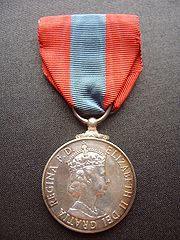
Imperial Service Order
Encyclopedia


Edward VII of the United Kingdom
Edward VII was King of the United Kingdom and the British Dominions and Emperor of India from 22 January 1901 until his death in 1910...
in August 1902. It was awarded on retirement to the administration and clerical staff of the Civil Service
Civil service
The term civil service has two distinct meanings:* A branch of governmental service in which individuals are employed on the basis of professional merit as proven by competitive examinations....
throughout the British Empire
British Empire
The British Empire comprised the dominions, colonies, protectorates, mandates and other territories ruled or administered by the United Kingdom. It originated with the overseas colonies and trading posts established by England in the late 16th and early 17th centuries. At its height, it was the...
for long and meritorious service. Normally a person must have served for 25 years to become eligible, but this might be shortened to 16 years for those serving in unsanitary locations. There was one class: Companion. Both men and women were eligible, and recipients of this order are entitled to use the post-nominal letters
Post-nominal letters
Post-nominal letters, also called post-nominal initials, post-nominal titles or designatory letters, are letters placed after the name of a person to indicate that the individual holds a position, educational degree, accreditation, office, or honour. An individual may use several different sets of...
'ISO'.
Insignia
The insignia of the order for men was an eight-pointed silver star, with the top ray obscured by a crown; the golden central medallion bore the cipherCipher
In cryptography, a cipher is an algorithm for performing encryption or decryption — a series of well-defined steps that can be followed as a procedure. An alternative, less common term is encipherment. In non-technical usage, a “cipher” is the same thing as a “code”; however, the concepts...
of the reigning monarch surrounded by the legend 'For Faithful Service'. This was suspended on a ribbon of crimson with a blue central stripe.
The insignia of the order for women had the same medallion as for men, surrounded by a silver laurel
Bay Laurel
The bay laurel , also known as sweet bay, bay tree, true laurel, Grecian laurel, laurel tree, or simply laurel, is an aromatic evergreen tree or large shrub with green, glossy leaves, native to the Mediterranean region. It is the source of the bay leaf used in cooking...
wreath and topped by a crown. This was suspended on a bow of crimson with a blue central stripe.
Imperial Service Medal
Non-managerial civil servants who complete 25 years service are eligible for the Imperial Service Medal (ISM) upon retirement. The medal is a silver circular medal bearing the effigy of the reigning monarch on the obverse, and the motif of a naked man resting after work with the legend 'For Faithful Service' on the reverse. The ribbon or bow pattern is the same as the Imperial Service Order.1993 reforms
During the 1993 reform of the British honours systemBritish honours system
The British honours system is a means of rewarding individuals' personal bravery, achievement, or service to the United Kingdom and the British Overseas Territories...
the British Government decided to make no new appointments to the Imperial Service Order; the Imperial Service Medal, however, continues to be awarded. In recent years, only the government of Papua New Guinea
Papua New Guinea
Papua New Guinea , officially the Independent State of Papua New Guinea, is a country in Oceania, occupying the eastern half of the island of New Guinea and numerous offshore islands...
continues to nominate candidates for the Order and the Medal.

